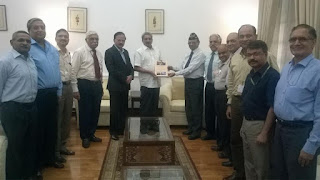The Lt Gen DB Shekatkar Committee—appointed by the government to enhance the combat potential of the armed forces and rebalancing defence expenditure—has recommended a number of measures to trim, redeploy and integrate manpower under the Ministry of Defence (MoD) in a gradual manner to meet the objective of an agile but effective military to meet current and future threats that India faces, BharatShakti has learnt after speaking to multiple sources including some members of the panel.
The Committee, which submitted the final report to Defence Minister Manohar Parrikar on 21 December 2016, has noted that if majority of its recommendations are implemented over the next five years, the government can save up to Rs 25,000 crore from its current expenditure. The Committee has however warned that the implementation cannot be selective. As the report has apparently noted: the redeployment of manpower from and downsizing of some of the organisations under the MoD will have to be across the board and ruthless to be effective. Moreover, the Shekatkar Committee has made it clear that the saving made as a result of its recommendations must be redeployed in enhancing the combat capabilities of the Indian armed forces and not be merged in the general budget.
After taking into account the nature threats that the country is likely to face in coming decades, the committee has in fact recommended that the defence budget should be in the range of 2.5 and three per cent of the GDP. This would however require a substantial change in approach and outlook of the government towards the armed forces. For the last five years for instance, defence budget has remained below two per cent of the GDP.
One of the major recommendations of the committee is to review the definition of ‘Capital’ and ‘Revenue’ budget heads in the funds allocated to the three armed forces, particularly the Indian Army. The panel notes that the Indian Army—unlike the Indian Navy and the Indian Air Force—will have to remain a manpower-intensive force because of its major deployment in the mountains against both its major adversaries, China and Pakistan. As a result the sustenance budget of the Indian Army will be higher than the other two services leaving very little money for capital acquisition. The panel has reportedly therefore recommended that a ‘roll on’ plan for fresh acquisitions be introduced so as to overcome the practice of ‘surrendering’ funds at the end of every financial year.
The panel has also suggested a review of the financial management system of the MoD in which the defence finance wing is seen to be more of an impediment in clearing projects and has recommended that the financial powers of all the three chiefs and vice chiefs be enhanced further to quicken the pace of acquisitions.
As for redeployment and rationalising of manpower, the Shekatkar Committee has recommended that the role of non-combat organisations paid for and sustained by the defence budget be subjected to a performance audit. Some of these organisations mentioned in the report are Defence Estates, Defence Accounts, DGQA, Ordnance Factory Board (OFB), DRDO, and the National Cadet Corps (NCC). Once a professional and objective review is carried out, the committee said, substantial savings can be achieved by downsizing or rationalising the manpower in these organisations.
The committee has also suggested the establishment of a Joint Services War College for training for middle level officers (the higher command course for instance), even as the three separate War Colleges—currently at Mhow, Secunderabad and Goa—for Army, Air Force and Navy could continue to train younger officers for their respective service. Similarly it has recommended that the Military Intelligence School at Pune be converted to a tri-service Intelligence training establishment.
Another aspect highlighted by the committee is the increasing reluctance on part of the state governments to renew lease of land for crucial firing ranges for the troops. Increasing urbanisation and pressure on land has meant that the armed forces have to battle political and bureaucratic pressure to retain the existing firing ranges. The panel has therefore suggested better coordination between the MoD and state governments to overcome this problem.
However the Committee has also suggested that the armed forces ramp up the quantum of training on various simulators. The new recruits can do about 60 per cent of their firing training on simulators, resulting in substantial savings to the tune of Rs 20-25 crore per annum in expenditure of training ammunition, the committee has suggested.
There are several other suggestions to improve efficiency of Border Roads Organisation (BRO), re-orienting the training staff of NCC by utilising more ex-servicemen and Junior Commissioned Officers (JCOs) to free young serving officers for more mainline jobs and even recommending the possibility of shifting NCC under the Human Resources Development (HRD) Ministry.
Like the previous such reviews ordered by the government, notably the Naresh Chandra Committee, the Shekatkar Committee too has said a 4-star Chief of Defence Staff (CDS)—or a Permanent Chairman Chiefs of Staff Committee—be appointed as a ‘chief coordinator’ between the military and the Ministry of Defence. It has however stressed on retaining the primacy of the three service chiefs in operational and administrative roles even while suggesting establishment of three or four integrated commands in medium to long term. This aspect will however need further deliberation at the highest level, the committee has suggested.
The entire report, it appears is focussed on shedding the flab in the MoD and make India’s armed forces more agile and technology-oriented to meet current and future national security objectives.

